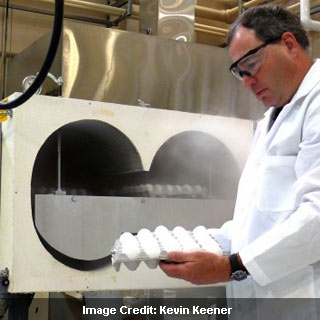
Scientists highlight that cooling of eggs after they are laid may lower the ability of salmonella to develop within eggs, thereby restricting people from falling sick. Presently, there no federal rules on how quickly eggs should be cooled, however current industry procedures take around six days to cool eggs to 45 degrees F. This particular temperature restricts salmonella growth. Keener’s quick cooling technology apparently takes two to five minutes.
Experts share that eggs can be greater than 100 F after washing and packaging in cartons. Further, thirty dozen eggs were bundled together in a case, and 30 cases were stacked onto pallets and were then placed in refrigerated coolers. Scientists shared that eggs in the center of the pallet can take around 142 hours to cool to 45 degrees. They reveal that one in about every 20,000 eggs may have salmonella within.
“The eggs in the middle of a pallet may take up to six days to cool, and if the one in 20,000 that has salmonella is in the middle, the bacteria will grow,” remarked Kevin Keener, an associate professor of food science. “In reality, some eggs don’t cool to 45 degrees until they’re in the refrigerator in your home.”
Food and Drug Administration studies highlight that if eggs are cooled and stored at 45 degrees or less within 12 hours of laying, there would be around 78 percent lesser salmonella illnesses from eggs in the United States every year. Keener’s cooling technology utilizes carbon dioxide snow to quickly reduce the eggs’ temperature. Eggs are then positioned in a cooling chamber and carbon dioxide gas at around minus 110 degrees is formed. The cold gas scatters around the eggs and develops a sleek layer of ice in the eggshell. The ice layer melts and rapidly reduces an egg’s inner temperature to below 45 degrees post treatment. Surprisingly, the eggshell does not break throughout the entire process since the shell has the capability to resist growth from a thin ice layer.
Previous analysis shared that the cooling treatment may augment shelf life by around four weeks. Paul Brennan, executive vice president of the Purdue-based Indiana State Poultry Association, shared that as long as Keener’s cooling technology did not negatively affect egg quality or producers, he would be amazed by this innovative technology.
“Our industry is good at adopting practical solutions. If there is a technology that we could adopt to address an issue and it was cost-effective, I’m sure we would embrace it. Continue to buy eggs, cook them properly and you will not have a problem from a health standpoint. Food is not sterile, but industry does everything it can to eliminate the possibility of illnesses,†Brennan added.
Keener has a sample of his rapid-cooling technology in his Purdue laboratory and is effectively working to enhance its function.
Presently, the FDA has ordered a recall of hundreds of millions of eggs thought to be infected by salmonella. Iowa’s Hillendale Farms and Wright County Eggs are considered to be the sources of the salmonella outbreak. Salmonella poisoning can affect people in several ways like causing fever, diarrhea, nausea, vomiting and abdominal pain.
